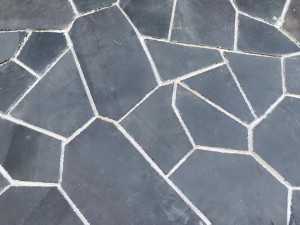- Working Time: 8 hours
- Total Time: 3 days
- Skill Level: Intermediate
- Estimated Cost: $150+
Flagstones, bricks, or pavers are options to make a backyard concrete patio more than a cold, gray slab. To start creating a patio for your yard, pick a spot where you want to build it and sketch a basic plan. Then, before you break ground, contact your local utilities to make sure you don't disturb any underground lines, pipes, or cables. Also, decide which method you'd like to use to install your patio: sand or mortar. This piece covers both ways.
Black irregular landscaping stones
Choosing Flagstone Patio Pieces
Flagstone patio paver pieces are fractured or cleft into flat slabs of various lengths, with 2 inches or more thickness and random edges. The flagstone most commonly used for patios include bluestone, limestone, redstone, sandstone, granite, and slate. Irregular shapes suit flagstone works for casual, free-form plans. Cut stone is flagstone finished with straight edges and square corners. It ranges from about 1 foot to 4 feet across and comes in different thicknesses. Cut flagstone is suited to more formal geometric designs.
Whatever type you choose for your flagstone patio pavers must be at least 2 inches thick to avoid cracking or breaking. A ton of stone covers about 120 square feet; order 5 percent more for breakage. Large stones cover a surface more quickly than smaller pieces but may prove more challenging to move, cut, and design.
Unlike ceramic tile, you can set flagstone in a sand base. A mortared installation, however, will give you years of maintenance-free use of your flagstone paver patio. A mortared patio requires a slab to provide a solid base. Cleft stone installations require an exterior mortar, generally Type M (which has high compressive strength) or Type S (high lateral strength).








